In this article we describe the IPv6 Matrix, a project tracking IPv6 Worldwide. It is especially interesting to see how World IPv6 Launch on 4 June 2012 has helped IPv6 deployment in certain countries.
Introduction
Two of the Regional Internet Registries (RIRs) have reached their last /8 of IPv4 address space which will be allocated based on special policies. The APNIC started allocating from their last /8 in April 2012 and the RIPE NCC has reached their last /8 on 14 September 2012. In the image below you can see the predictions on when the other RIRs will approximately run out of IPv4 (when you click on the image, you will get to the most up to date graph).
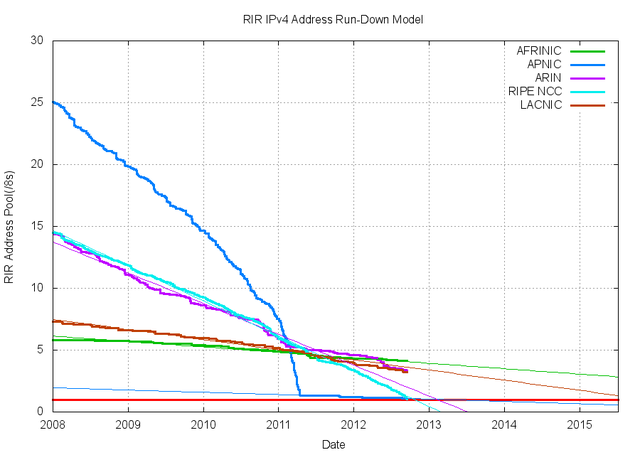
During World IPv6 Launch on 4 June 2012, many network operators, web companies, home router vendor and other Internet companies agreed to switch on IPv6 permanently. We wanted to find out if this has actually worked and how it improved IPv6 deployment in various regions.
The IPv6 Matrix project
The Internet Society chapter in the UK (ISOC England) has been awarded a community grants award in November 2009 to design and implement an "IPv6 crawler", a software that would crawl through the DNS at regular intervals in order to detect and test the following:
- IPv6 DNS servers
- IPv6 compliant web servers
- IPv6 compliant SMTP servers
- IPv6 compliant NTP servers
Methodology
Today over 95% of Internet traffic is generated by a small number of web sites. That means without IPv6 accessible content, IPv6 has no chance of ever being used and deployed widely.
We took the 1 million most popular web sites from alexa.com as a starting point to identify those domains that should be tested. More domains were then added later. We tested if these domains are reachable over IPv6. Note that this is equivalent to testing about 6.3. million hosts worldwide. A GeoIP database was used to determine the location of each host.
What are we tracking?
In order to determine host IPv6 penetration under country-code top level domains (ccTLDs) and a number of generic TLDs (.com, .net, .org), we looked at two types of information:
- Infrastructure required to run IPv6 services: DNS + Web + email+ NTP server
- Actual web content (this usually shows a lower percentage than infrastructure)
We also tested connectivity to these services (in case IPv6 addresses were advertised but no service was running on them). We also traced the route between our server at the London Docklands to each host on the list, using both IPv4 and IPv6 (all this information is archived in text format). All that is providing a lot of data, accessible from the IPv6 Matrix web site archive . In August 2012 over a dozen full runs were completed, each run taking a month and a half to complete. The size of this database was approximately 160 Gb and it is still increasing (the testing software runs 24 hours a day).
Results
Trends in Europe
Luxembourg, Norway and Germany see significant rise in IPv6 enabled infrastructure since World IPv6 Launch. This is likely to be caused by one major hosting provider installing dual-stack name servers. Slovakia and Portugal are leading with the number of dual-stack web sites. The Czech Republic shows the highest growth in dual-stack web sites during this period. Germany is the country with the largest number of dual-stack web sites in Europe.
The image in Figure 1 shows IPv6 enabled infrastructure in Europe measured on 4 June 2012 (blue) and in August 2012 (red).
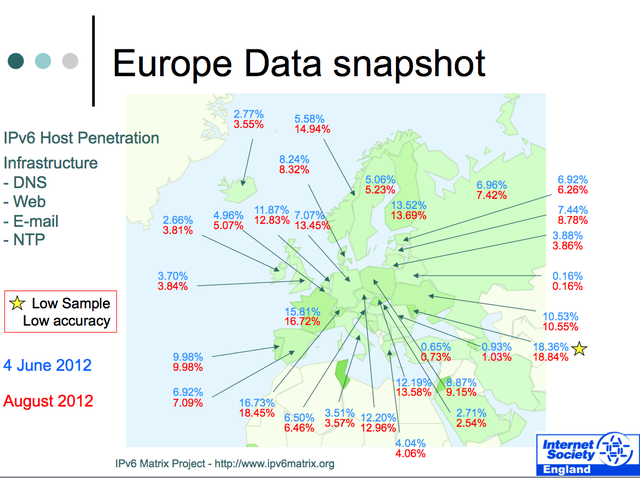
The image in Figure 2 shows IPv6 enabled web sites in Europe measured on 4 June 2012 (blue) and in August 2012 (red).
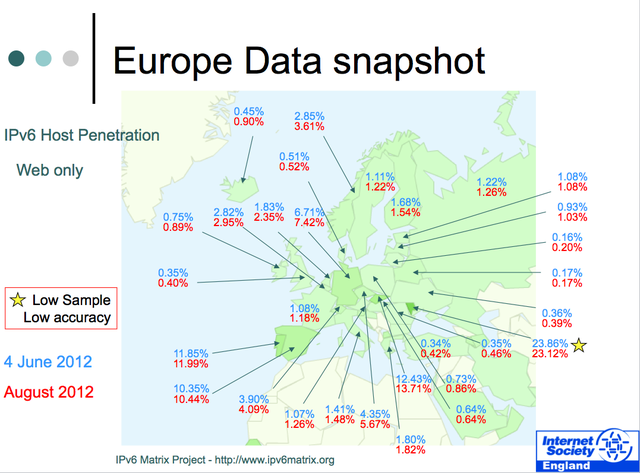
Trends in Asia
Singapore is still leading by far in terms of IPv6 enabled infrastructure, but is trailing in dual-stack web sites. Armenia shows a growth of 2.72% in IPv6 infrastructure within two months. China shows abnormally low results. It is not clear if this is caused by content not being dual-stacked or the fact that IPv6 is hidden behind a firewall. India also shows low results, both in IPv6 infrastructure and the most popular web sites. Please note that the results for Asia are less reliable due to a smaller sample size in many countries in that region.
The image in Figure 3 shows IPv6 enabled infrastructure in Asia measured on 4 June 2012 (blue) and in August 2012 (red).
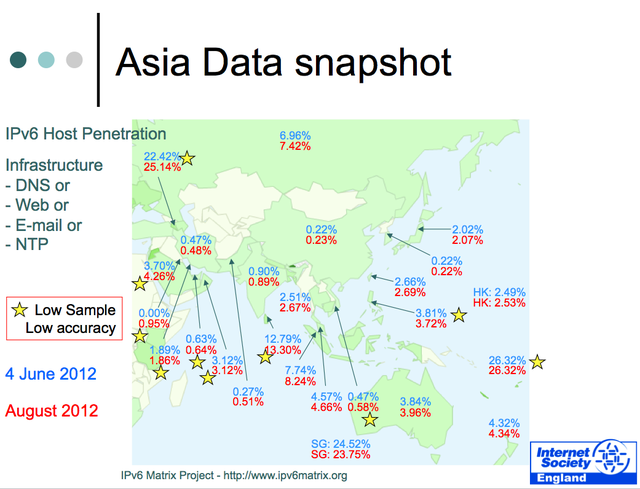
The image in Figure 4 shows IPv6 enabled web sites in Asia measured on 4 June 2012 (blue) and in August 2012 (red).
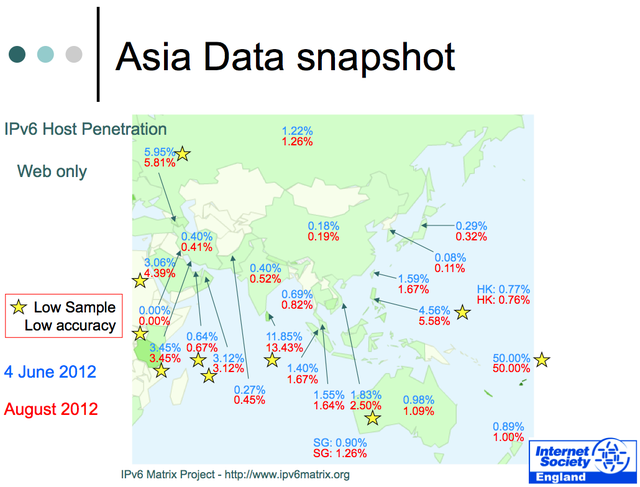
Trends in Africa
Many countries in Africa have IPv6 capabilities and local infrastructure, some through tunnels. South Africa shows the fastest growth in IPv6 enabled infrastructure. It is also interesting to see some dual-stack islands appear on the continent.
The image in Figure 5 shows IPv6 enabled infrastructure in Africa measured on 4 June 2012 (blue) and in August 2012 (red).

The image in Figure 6 shows IPv6 enabled web sites in Africa measured on 4 June 2012 (blue) and in August 2012 (red).
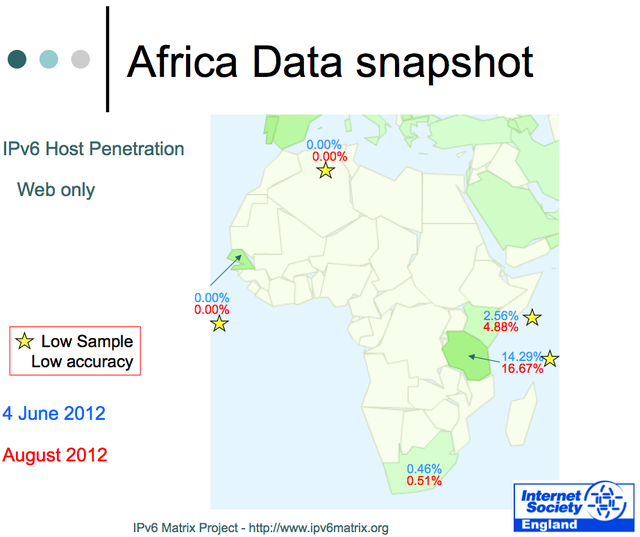
The current development in Africa can be compared to the growth of Internet connectivity in the 1990s. In the two maps below you can see how many countries were connected in June 1994 (on the left side) and in May 1997 (on the right side). Full Internet connectivity is in yellow with red cross-pattern. UUCP dial-up only connectivity is in green. Please refer to the Internetology web site for more information on other continents and dates.
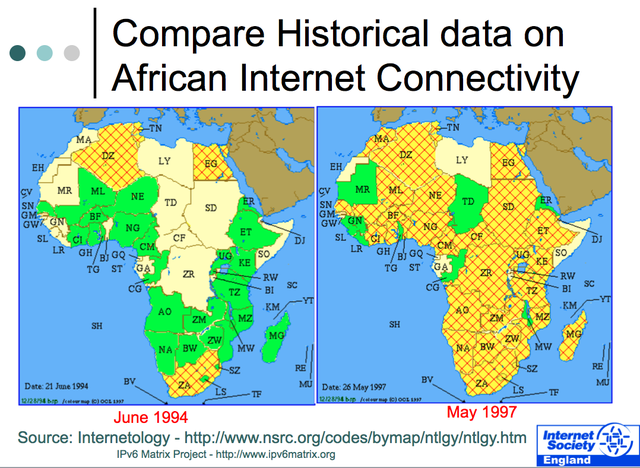
Trends in North and South America
The US shows a significant growth, both in IPv6 enable infrastructure and in the number of dual-stacked web sites. This seems to be directly related to the World IPv6 Launch. Also Chile shows significant growth (5.39%) in infrastructure. Canada is trailing in the percentage of dual-stacked web sites. Note that in other countries, the data is based on a low number of web sites (the restricted number of hosting providers can make figures jump several percentage points).
The image in Figure 7 shows IPv6 enabled infrastructure in the Americas measured on 4 June 2012 (blue) and in August 2012 (red).
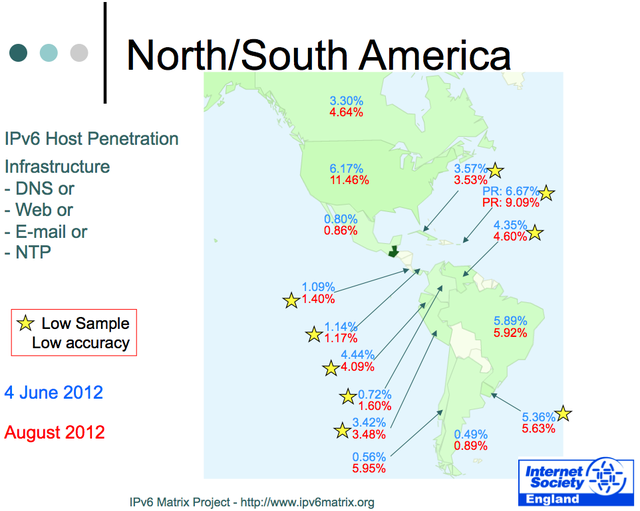
The image in Figure 8 shows IPv6 enabled web sites in the Americas measured on 4 June 2012 (blue) and in August 2012 (red).
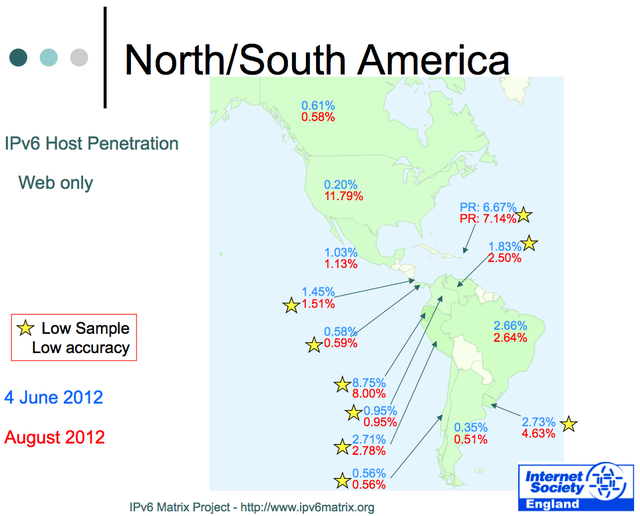
Worldwide Trends
On a global scale, we are still seeing a slow growth in the deployment of dual-stacked hosts. A decrease in percentage in some countries could be related to unstable peering arrangements (the IPv6 network is less densely meshed than the IPv4 network). The US has clearly shown the fastest growth in this period, most likely a direct result of the World IPv6 Launch. Some small countries like Luxembourg had their main ISPs start offering dual-stack and consequently showing some growth in dual-stacked infrastructure. Bearing in mind that the Regional Internet Registry for the Asia Pacific (APNIC) has already reached their last /8 earlier this year, it is alarming to see so few web sites running IPv6 in that region, especially in countries with very high Internet growth like India. The World IPv6 Launch seemed to have had no impact in those countries.
Possible Errors/Caveats
We detected many errors in the DNS (commas, no A or no AAAA records, looping MX records etc.). Sometimes firewall and security software was blocking network segments or they are detecting denial of service attacks by mistake (some firewalls detect "ping" as being a denial of service attack and they detect "traceroute" as a hacking attack - thus blocking all traffic from the source address.).
Also note that the results provide a snapshot from one location only. As mentioned above, we achieved less accurate results in places we could only test a small number of domains (not enough significantly large local Web sites by traffic). Finally, the accuracy of the GeoIP database is disputable.
Future Work
The current front end web pages are only an example of possible analysis. In the future we are hoping to:
- Develop new data visualisation
- Perform further analysis
- Perform historical analysis and analysis over a longer period of time from archives
- Develop an engine to write automated reports
We are also planning to duplicate the crawler software to other regions to create multiple views. You can find more information on the IPv6 Matrix web site . If you are interested in some more details or if you would like to support this project, please contact us at ISOC England < contact@isoc-e.org >.

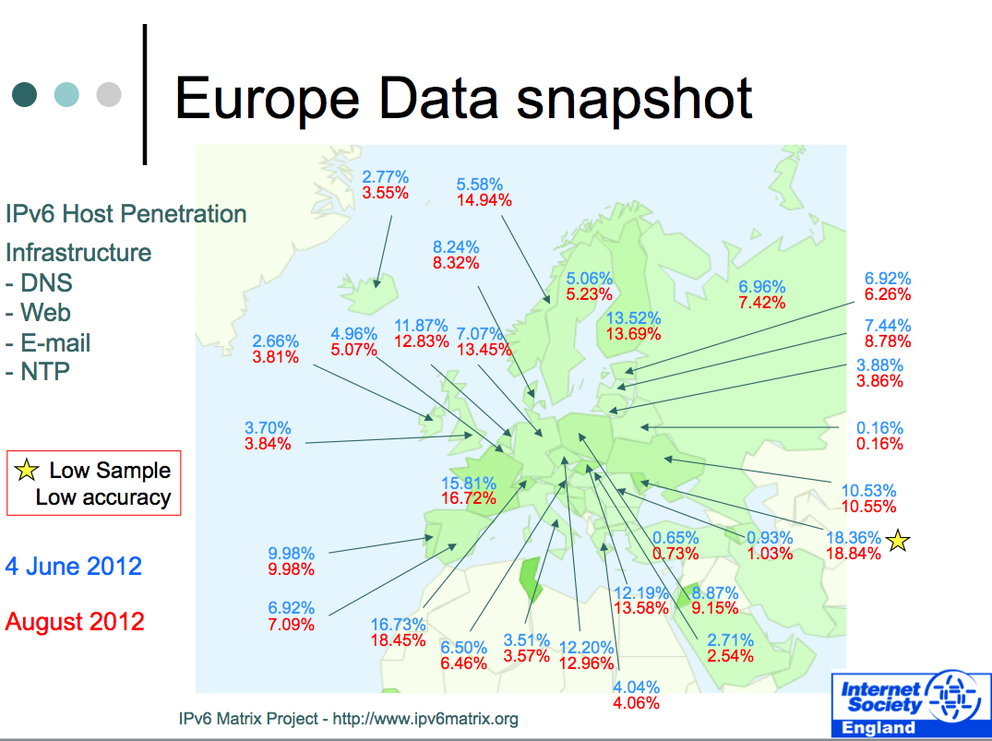
Comments 0
The comments section is closed for articles published more than a year ago. If you'd like to inform us of any issues, please contact us.